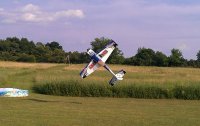njswede
150cc
Description
Flying knife-edge (often abbreviated KE) means flying the plane with the wings in a vertical orientation. The wings do not generate any lift in the configuration, so the fuselage acts as a lifting surface. Generous amounts of rudder are usually needed to keep the plane from losing altitude.

Joe Smith flying a killer high-beta knife-edge at the Fly-Low-In in New Jersey. (Photo: Pontus Rydin)
Level of difficulty
Easy-medium
Entering from upright flight
Apply aileron to perform a quarter roll and give opposite rudder to keep the airframe from losing altitude.
Entering from inverted flight
Apply aileron to perform a quarter roll and give rudder input in the same direction as the aileron to keep the airframe from losing altitude.
Entering from hover
Apply rudder to perform a half hammerhead and then immediately apply opposite rudder increase throttle to keep the plane flying.
Steering
When flying knife edge, the elevator is used to make turns. Apply down elevator to turn towards the belly of the plane and up elevator to turn toward the canopy. When turning, you will probably need to make some rudder and aileron adjustments to keep the plane in a stable knife edge.
Altitude is typically controlled using the throttle. An interesting fact about knife-edge is that it is very hard to stall the plane when in a knife-edge orientation. Therefore, reducing throttle input usually yields a gentle descent. Rudder should be used to control the angle of attack, rather than the altitude. Due to the characteristics of the fuselage as a lifting surface, it is usually quite easy to fly knife edges with very high angles of attack.
Exiting
The easiest way of exiting a knife-edge is obviously to do a quarter-roll back to upright or inverted. However, you may also apply rudder to either put the plane in an up-line or perform a "half hammerhead" to put the plane in a vertical dive.
Common mistakes
Wrong rudder direction
This mistake has probably caused the demise of many airframes. There are two basic rules of thumb:
The higher the angle of attack, the more coupling between the control surfaces you are going to have. When practicing knife-edges, it's wise to start using more throttle and less rudder to keep the plane flying.
Tips
Most airframes have some coupling between the control surfaces when flying knife-edge. This can be mixed out and it is strongly recommended you do that to make sure you are not constantly fighting to keep the airframe at a steady orientation. See 3Dpedia entry, Knife-Edge Mixing.
Practice entering and existing knife-edges in a simulator until the rudder direction becomes second nature. This will make your knife-edge flying more enjoyable and less nerve-wrecking. And you'll save money on airframes too...
Flying knife-edge (often abbreviated KE) means flying the plane with the wings in a vertical orientation. The wings do not generate any lift in the configuration, so the fuselage acts as a lifting surface. Generous amounts of rudder are usually needed to keep the plane from losing altitude.

Joe Smith flying a killer high-beta knife-edge at the Fly-Low-In in New Jersey. (Photo: Pontus Rydin)
Level of difficulty
Easy-medium
Entering from upright flight
Apply aileron to perform a quarter roll and give opposite rudder to keep the airframe from losing altitude.
Entering from inverted flight
Apply aileron to perform a quarter roll and give rudder input in the same direction as the aileron to keep the airframe from losing altitude.
Entering from hover
Apply rudder to perform a half hammerhead and then immediately apply opposite rudder increase throttle to keep the plane flying.
Steering
When flying knife edge, the elevator is used to make turns. Apply down elevator to turn towards the belly of the plane and up elevator to turn toward the canopy. When turning, you will probably need to make some rudder and aileron adjustments to keep the plane in a stable knife edge.
Altitude is typically controlled using the throttle. An interesting fact about knife-edge is that it is very hard to stall the plane when in a knife-edge orientation. Therefore, reducing throttle input usually yields a gentle descent. Rudder should be used to control the angle of attack, rather than the altitude. Due to the characteristics of the fuselage as a lifting surface, it is usually quite easy to fly knife edges with very high angles of attack.
Exiting
The easiest way of exiting a knife-edge is obviously to do a quarter-roll back to upright or inverted. However, you may also apply rudder to either put the plane in an up-line or perform a "half hammerhead" to put the plane in a vertical dive.
Common mistakes
Wrong rudder direction
This mistake has probably caused the demise of many airframes. There are two basic rules of thumb:
- When entering from upright, apply opposite rudder to aileron. When entering from inverted, apply rudder in the same direction as the aileron.
- When the canopy is facing you, apply rudder towards the tail. When the belly is facing you, apply rudder toward the nose.
The higher the angle of attack, the more coupling between the control surfaces you are going to have. When practicing knife-edges, it's wise to start using more throttle and less rudder to keep the plane flying.
Tips
Most airframes have some coupling between the control surfaces when flying knife-edge. This can be mixed out and it is strongly recommended you do that to make sure you are not constantly fighting to keep the airframe at a steady orientation. See 3Dpedia entry, Knife-Edge Mixing.
Practice entering and existing knife-edges in a simulator until the rudder direction becomes second nature. This will make your knife-edge flying more enjoyable and less nerve-wrecking. And you'll save money on airframes too...
Last edited by a moderator:
